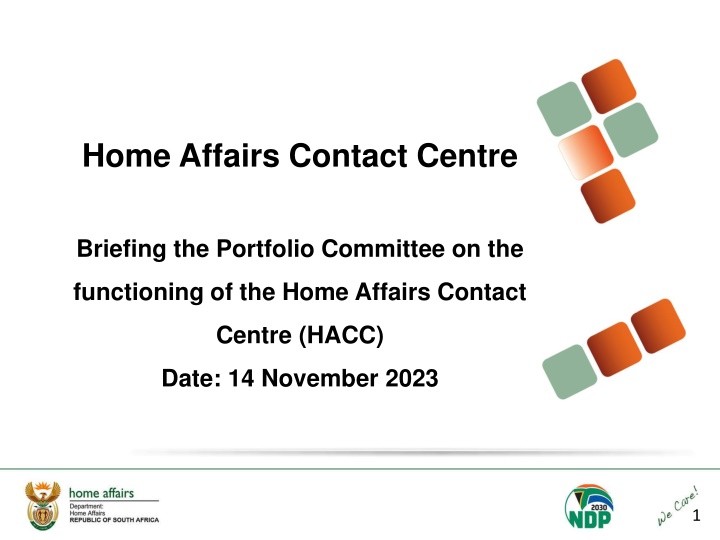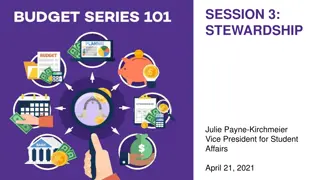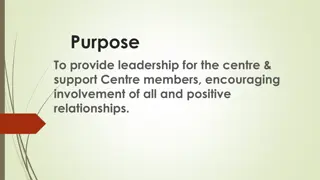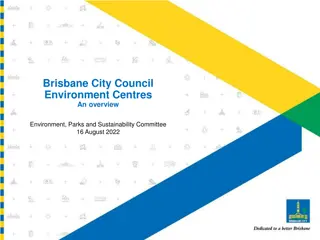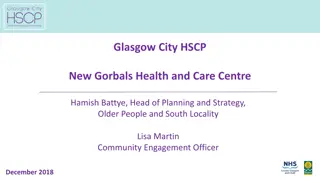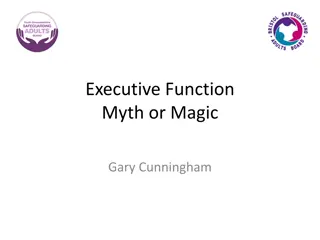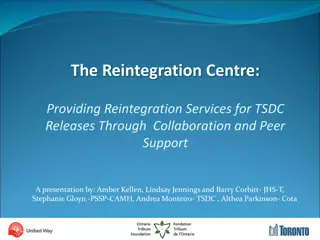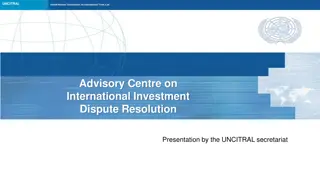Home Affairs Contact Centre Functioning Overview
Home Affairs Contact Centre (HACC) plays a vital role in managing complaints, queries, and compliments related to government services. Established in alignment with the DPSA framework, it aims to ensure effective service delivery and uphold the right of redress. The implementation of the HACC framework involved consolidating complaint management units and establishing an integrated Contact Centre system. Guided by key principles and procedures, the HACC strives to provide timely and efficient assistance to the public and stakeholders.
Download Presentation

Please find below an Image/Link to download the presentation.
The content on the website is provided AS IS for your information and personal use only. It may not be sold, licensed, or shared on other websites without obtaining consent from the author.If you encounter any issues during the download, it is possible that the publisher has removed the file from their server.
You are allowed to download the files provided on this website for personal or commercial use, subject to the condition that they are used lawfully. All files are the property of their respective owners.
The content on the website is provided AS IS for your information and personal use only. It may not be sold, licensed, or shared on other websites without obtaining consent from the author.
E N D
Presentation Transcript
Home Affairs Contact Centre Briefing the Portfolio Committee on the functioning of the Home Affairs Contact Centre (HACC) Date: 14 November 2023 1
Presentation Outline 1. Background on the implementation of HACC 2. Guiding principles and standard operating procedures 3. Contact Centre structure 4. Roles and responsibilities of the Home Affairs Contact Centre with regards to complaints and queries management 5. Contact Centre systems and Technology 6. Contact Centre Statistics- Historic Analysis 7. A fit for purpose Contact Centre 2 #
Background on the implementation of HACC 1. In order to effectively fulfil its developmental mandate and as an integral feature of good governance and effective service delivery, government has to ensure that systems, processes and procedures are continuously reviewed and that service delivery complaints are managed effectively and the right of redress is upheld. 2. To ensure that the above is realised, in 2014, the Department of Public Service and Administration developed a complaints and compliments management framework governing the handling, resolution and recording of all enquiries, queries, complaints and compliments registered with all government departments. 3. To align itself with the DPSA framework, in September 2014, the Minister of Home Affairs approved the Home Affairs Contact Centre Framework that now serves as the guiding principle for handling of all complaints and compliments raised with the Department. Embedded in the framework is the implementation of a 3(three) tier integrated contact centre system to effectively manage contacts with the public and all other stakeholders. 4. To realize the objectives of the Home Affairs Contact Centre framework, in 2015 all complaints management units in the Department of Home Affairs were consolidated into one unit, reporting to the Director: Home Affairs Contact Centre. This was to ensure one entry point for all complaints, enquiries and queries channeled to the Department by members of the public and chapter nine institutions. 5. The second leg of the project to implement the Home Affairs Contact Centre framework was the establishment of an integrated, unified messaging in-house Contact Centre with capabilities to run on top of and integrate with core business systems with real-time information provided to the end-users. 3 #
Guiding principles and standard operating procedures 1. The Home Affairs Contact Centre is guided by: The DPSA principles on the management of complaints, queries, enquiries and compliments, The Batho Pele principles, Home Affairs Contact Centre framework, The approved DHA Service Charter and its related service standards The approved Contact Centre Standard Operating procedures, call flow and workflow processes. Department of Home Affairs Acts and Regulations Public Access to Information Act (PAIA) Public Access to Justice Act (PAJA) Constitution of the Republic of South Africa. 4 #
Capacity Outline Post Approved number of posts Number of filled posts Number of vacant posts % filled Director 1 1 0 100% Deputy Director 3 1 2 33% Assistant Director 8 6 2 75% Team Leaders 20 11 9 55% Senior Case Resolution Clerks 30 2 28 6.6% Case Resolution Clerks 120 51 69 42.5% Contact Centre Consultants 120 84 64 on calls 20 on e-mails 36 70% Total posts 302 156 146 54% The Centre is currently operating at 54% capacity from 68% capacity it had in 2018 5 #
Roles and Responsibilities of the Home Affairs Contact Centre The centre reports to the Deputy Director-General: Operations The centre is managed by the Director: Home Affairs Contact Centre For risk and control purposes, the unit is divided into two sub-directorates with clearly distinguished roles and responsibilities. The sub-directorates are located in different locations for easy access to systems, information, records, files and core business staff members needed for finalization and resolution of complaints and queries. For easy management and monitoring of staff, all Contact Centre staff is accommodated in open plan areas with team leaders sitting close to their teams. The integrated Home Affairs Contact Centre is implemented through the following structures: First-line contact centre (Tier1); Serves as the main point of contact with the public through multiple access channels Screens (using relevant core business systems) and registers all interactions on the case management system. Resolves information requests on the spot and electronically escalates all requests for service (Where investigation or finalization of an application is required) to Second-line case resolution facilitation centre. Provides updates on logged cases to customers using the relevant Contact Centre and core business systems. 6 #
Roles and Responsibilities of the Home Affairs Contact Centre Second-line case resolution facilitation centre (Tier 2); Receives and acknowledges and investigates electronically escalated cases from first line contact centre, Executive Management and Chapter Nine Institutions Facilitate the resolution of cases- *Check all relevant systems for the status of applications. *Interact with customers, various business units during the process of resolving different categories of cases (*request and draw records where necessary, request supporting documents from record centres, customers and other institutions like birth registers, marriage records, divorce decrees and finalize the applications on the Department s systems or submit documents to business units for finalization of applications that are outside their scope of work. Provide feedback to customers and redress where needed. Arrange meetings between customers and the Department, for example, immigration interview, when applicable). NB: There should be a case registered on the case management system, reported by the customer themselves, Executive Management or a Chapter Nine Institutions through the relevant channels, with a case reference number for the application to be processed by Tier-2 contact centre team. Third-line case/ application finalization nodal points in line function units (Tier 3); Receives and investigates electronically escalated cases from second line contact centre team Request for supporting documents where needed from records centres or second line team and finalize applications for enabling documents. Attend to complex queries and investigations and provide outcomes to Tier 2 team Update case management system to enable both Tier 2 and 1 to respond to customer requests for status updates. Weekly query meetings are held with Tier 3 management to discuss strategies to deal with all pending cases in line with the service level agreements between the Contact Centre and business units. 7 #
Roles and Responsibilities of the Home Affairs Contact Centre Other key Contact Centre responsibilities: Analyse Contact Centre data for trends and case studies. Highlight the most common causes of complaints about the services of the DHA and report to executive management with the aim of improving service delivery. Measure customer complaints against set performance and service standards and use results as a management tool to improve service delivery (use contact centre statistics and reports to input into the development of the Department s service delivery improvement plan) Serve as a monitoring tool to improve the quality and accessibility of services to the clients Quality Assurance team within the Contact Centre: The purpose of quality management unit within the Contact Centre is to provide a foundation for achieving excellent customer service that is in line with the department s mission, vision and values. Emphasis is put on delivering an excellent customer experience in line with existing government policies namely Batho Pele, Moeta Pele, The DHA Service Delivery Charter, DHA code of conduct. In keeping up with the demand for quality service, the quality team is responsible for: Conducting quality audits in the centre and ensuring that officials provide good, timely and professional customer service to clients. Ensure a culture of coaching in the centre by implementing processes that ensure regular monitoring, evaluating interactions and giving feedback to the officials on their performance during their interaction with customers. Ensure data integrity and quality of information provided to customers 8 #
Monitoring and Evaluation The implementation of the Contact Centre framework is monitored in line with the international Contact Centre performance metrics (25 set metrics) The Department of Home Affairs Contact Centre currently utilizes three metrics which are selected in line with the Department s vision, mission, values and slogan. AHT= Average Call Handling time which includes the talk time, hold time and wrap-up time Adherence to schedule=reveals whether or not agents are adhering to their assigned schedules. The metric is defined as a percentage of the working day where an agent is available to take calls. Case management= assesses the quality of data captured and the management of cases by agents All Contact Centre interactions are recorded for quality assurance and performance monitoring. Recordings are used to check the quality of the interactions and adherence to performance standards. Management information system reports and quality assurance system templates are used to measure, monitor and evaluate performance. Real-time and historic reports are used to monitor adherence to set standards, operating hours and behavioural patterns from both staff and customers. Calibration sessions are used to evaluate interactions and improve individuals and centre wide performance. Weekly coaching sessions using the GROW coaching model are conducted. Follow up sessions done where necessary based on the outcomes of the sessions. Statistical reports on interactions and cases recorded are drawn every day, week and month and discussed with affected parties. 9 #
Contact Centre systems and technology Technology, though aligned to business processes and forms the basis of operations in the centre. The integrated Home Affairs Contact Centre has 3 main systems and also access to core business systems for easy resolution of queries and enquiries: Presence telephony management system 10.1 version with: Integrated Voice Response system for queuing and routing of calls to agents or self-service line (currently deactivated), voice and screen recording of interactions (all Contact Centre voice interactions are recorded for quality and training purposes with screen recording only available for 15 computers at a time), announcements, messages and division of interactions into various products (e.g. Civic Services calls/ IMS calls) and sub-products (birth, appeals etc.). Automated Call distributor for distribution of calls from the Integrated Voice Response system to the agents. The distribution rule is for the call to go to the longest waiting agents on the floor. Management information Services for management of calls, staff performance, and statistics on number of calls received, total calls abandoned, time taken to answer calls, time taken on the call itself, caller identification and service levels for groups and the entire centre. Knowledge database for storage of information documents like frequently asked questions, circulars, standard operating procedures, tariffs, service standards, service points database to assist with responses for information requests (searchable but interactive). CRM case management system 2016 version: For logging new cases, updating open cases, escalation of cases to relevant sections for resolution of queries or finalization of applications. For management reports on cases logged, escalated, updated and resolved. 10 #
Contact Centre systems and technology Qlik Sense Business Analytical tool 2019 version: It provides trends on queries logged focusing on product categories, sub-categories and reports provided. The system also provided analysis on individual performance and centre performance (everything on the tool is automated, no human interventions). This includes but not limited to average call handling time per individual, breaks taken, adherence to schedule, total calls handle by an individual in an hour, day, week, month and Team leader escalations reports etc. Call arrival patterns over a period of time (days, weeks, months ) Report on calls handled on Presence versus cases created on CRM Case Management system by the agents for the day, week, month and year. The Contact Centre has access to the following core business systems: National Population register (both query functions and some production functions) Live Capture- Service manager Records systems (Templates and EDMS) QA system for Citizenship Movement Control Cstem Visa Adjudication System NIIS 11 #
Calls Received For the Year 2018 -2019-2023 Year Calls Received Calls Answered Abandoned Calls Total staff on telephone channel January to December 2018 1 168 917 1 075 403 (92%) 93514 (8%) 95 January to December 2019 1 120 301 1 011 632 (90.3%) 108669 (9.7%) 92 January to October 2023 989 204 721731 (84%) 137472 (16%) 64 Calls Received Per Product Calls Received Per Service Group 12
A FIT FOR PURPOSE CONTACT CENTRE To realize the benefits of a fully functional Contact Centre, the below should be put in place Implementation of an integrated Contact Centre solution, with all channels automated and running on the same platform to allow for scalability, interoperability of systems and a single view of the customer and agents. Implementation of multiple access channels with full self-service functionalities integrated to core business systems to increase first contact resolution and free agents to focus on resolution of escalated cases Integration of Contact Centre systems to core departmental systems for real- time access to information Deployment of systems with interactive knowledge base and reports solutions informed by changing social, economical and technological environments. As the Contact Centre industry is a highly paced industry, Contact Centre systems and solutions to be updated and upgraded on a three to five year basis. Recruitment and staffing to be aligned to Contact Centre industry best practices 15
RECOMMENDATIONS It is recommended that the Portfolio Committee notes the presentation on the Department of Home Affairs Contact Centre. 16
Thank You 17
